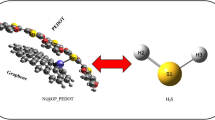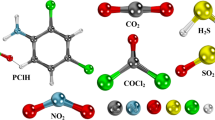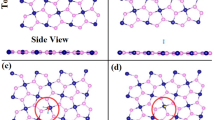Abstrac
We investigated the adsorption of associated petroleum gas (APG) molecules: methane (CH4), ethane (C2H6), propane (C3H8), butane (C4H10), pentane (C5H12), nitrogen (N2), and carbon dioxide (CO2) on the surface of (6, 0) zigzag SWCNT using density functional theory (DFT) calculations to explore a highly sensitive nanosensor for these molecules which take great attention due to environmental and industrial considerations. To better understand the energetic and electronic properties, which include the adsorption energies, HOMO energies, Fermi level energies, LUMO energies, energy gaps, work functions, dipole moments, and the reactivity descriptors are performed for SWCNT in free mode and interacted with the above gas molecules. The molecular electrostatic potential and the electron density surfaces have been constructed. Moreover, we used orbital analysis counting the density of states (DOS) to finding out the possible orbital hybridization between APG molecules and SWCNT. Based on the results, we believe that SWCNT has potential to be a new effective nanosensor for APG molecules.
Similar content being viewed by others
References
A. Knizhnikov and N. Poussenkova, Preprint (World Wildlife Federation, Inst. World Economy and Int. Relations, Russia, 2009).
T. H. Roland, Policy 37, 407 (2008).
H. Devold, Oil and Gas Production Handbook: An Introduction to Oil and Gas Production (Lulu.com, 2013).
A. Solov’yanov, Russ. J. Gen. Chem. 81, 2531 (2011).
S. Moon, N.M. Vuong, D. Lee, D. Kim, H. Lee, D. Kim, S.-K. Hong, and S.-G. Yoon, Sens. Actuators, B 222, 166 (2016).
M. Asad and M. H. Sheikhi, Sens. Actuators, B 231, 474 (2016).
X. Zhang, H. Cui, Y. Gui, and J. Tang, Nanoscale Res. Lett. 12, 177 (2017).
H. Elhaes, A. Fakhry, and M. Ibrahim, Mater. Today: Proc. 3, 2483 (2016).
G. A. Rivas, M. D. Rubianes, M. L. Pedano, N. F. Ferreyra, G. Luque, and S. A. Miscoria, in New Topics in Electrochemistry Research, Ed. by M. Nunez (Nova Science, New York, 2006), p. 1.
R. Jaaniso and O. K. Tan, Semiconductor Gas Sensors (Elsevier, Amsterdam, 2013).
S. Reich, C. Thomsen, and J. Maultzsch, Carbon Nanotubes: Basic Concepts and Physical Properties (Wiley, New York, 2008).
M. J. O’Connell, Carbon Nanotubes: Properties and Applications (CRC, Boca Raton, FL, 2006).
M. Yoosefian, Z. Barzgari, and J. Yoosefian, Struct. Chem. 25, 9 (2014).
A.D. Becke, J. Chem. Phys. 98, 5648 (1993).
C. Lee, W. Yang, and R. G. Parr, Phys. Rev. B 37, 785 (1988).
M. J. Frisch, H. B. Schlegel, G. E. Scuseria, M. A. Robb, J. R. Cheeseman, G. Scalmani, V. Barone, B. Mennucci, G. A. Petersson, H. Nakatsuji, M. Caricato, X. Li, H. P. Hratchian, A. F. Izmaylov, J. Bloino, et al., Gaussian 09, Rev. A.02 (Gaussian, Inc., Wallingford CT, 2016).
A. M. Khuodhair, F. N. Ajeel, and M. O. Oleiwi, J. Appl. Phys. Sci. Int. 6, 202 (2016).
F. N. Ajeel, A. M. Khudhair, and A. A. Mohammed, Int. J. Sci. Res. 4, 2334 (2015).
C. J. Cramer, Essentials of Computational Chemistry: Theories and Models (Wiley, Chichester, 2013).
M. Oftadeh, S. Naseh, and M. Hamadanian, Comput. Theor. Chem. 966, 20 (2011).
M. Oftadeh, M. Gholamian, and H. H. Abdallah, Int. Nano Lett. 3, 1 (2013).
P. Pannopard, P. Khongpracha, M. Probst, and J. Limtrakul, J. Mol. Graph. Model. 28, 62 (2009).
M. Noei, J. Mol. Liq. 224, 757 (2016).
M. Eslami, V. Vahabi, and A. A. Peyghan, Phys. E (Amsterdam, Neth.) 76, 6 (2016).
G. Vallejo-Fernandez, N. Aley, J. Chapman, and K. O’Grady, Appl. Phys. Lett. 97, 222505 (2010).
S. Chen, S. Scheiner, T. Kar, and U. Adhikari, Int. J. Electrochem. Sci. 7, 7128 (2012).
M. H. Al-Abboodi, F. N. Ajeel, and A. M. Khudhair, Phys. E (Amsterdam, Neth.) 88, 1 (2017).
S. S. Li, Semiconductor Physical Electronics (Springer Science, New York, 2012).
Author information
Authors and Affiliations
Corresponding author
Additional information
The article is published in the original.
Rights and permissions
About this article
Cite this article
Ajeel, F.N., Mohammed, M.H. & Khudhair, A.M. SWCNT as a Model Nanosensor for Associated Petroleum Gas Molecules: Via DFT/B3LYP Investigations. Russ. J. Phys. Chem. B 13, 196–204 (2019). https://doi.org/10.1134/S1990793119010020
Received:
Revised:
Accepted:
Published:
Issue Date:
DOI: https://doi.org/10.1134/S1990793119010020




